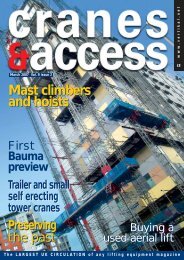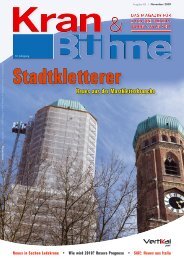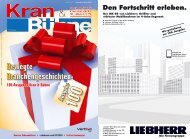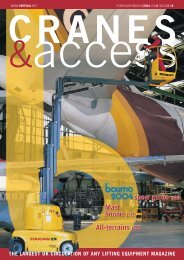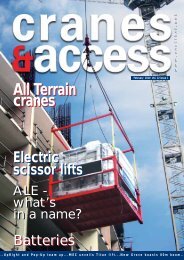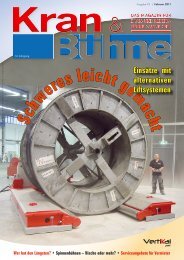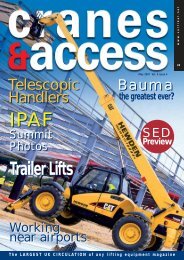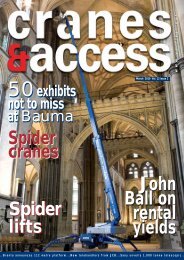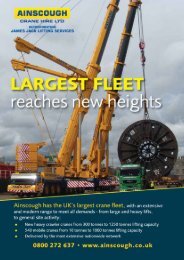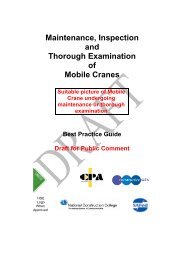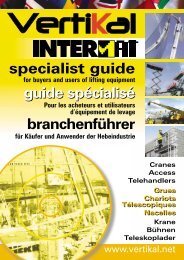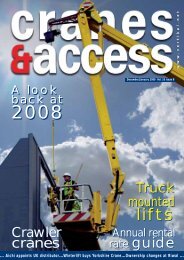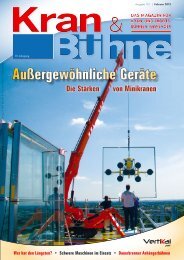1 GUIDELINES ON REQUIREMENTS FOR SAFETY DEVICES ON ...
1 GUIDELINES ON REQUIREMENTS FOR SAFETY DEVICES ON ...
1 GUIDELINES ON REQUIREMENTS FOR SAFETY DEVICES ON ...
Create successful ePaper yourself
Turn your PDF publications into a flip-book with our unique Google optimized e-Paper software.
<strong>GUIDELINES</strong> <strong>ON</strong> <strong>REQUIREMENTS</strong> <strong>FOR</strong> <strong>SAFETY</strong> <strong>DEVICES</strong> <strong>ON</strong> MOBILE ELEVATING WORK PLAT<strong>FOR</strong>MS (MEWPS)<br />
TO BE APPLIED BE<strong>FOR</strong>E THE PUBLICATI<strong>ON</strong> OF AS1418-10 (2010)<br />
VERSI<strong>ON</strong> AS OF 27 MAY 2010<br />
Purpose<br />
The purpose of this document is to set out the interim requirements for safety devices on new or imported Mobile Elevating<br />
Work Platforms (MEWPs) used in Australia.<br />
Background<br />
The Australian Standard for EWPs (AS1418-10) was recently reviewed and requirements for safety devices were included to<br />
bring the relevant Australian requirements in line with European requirements under EN280. Unfortunately there is a delay<br />
in the publication of the revised AS1418-10. At the same time, the requirements for safety devices under EN280 are also<br />
being reviewed. Consequently, it is not possible at this point in time, to rely on any of these two standards to determine the<br />
requirements on safety devices for new MEWPs in Australia.<br />
The Australian Regulators’ Committee on High Risk Plant consulted extensively with industry (particularly the Elevating Work<br />
Platform Association of Australia Inc (EWPA) and agreed that a document setting out the interim requirements for safety<br />
devices on MEWPs should be developed and published by the Regulators’ Committee. The document will be reviewed<br />
when either AS1418-10 has been published or the review on EN280 has been finalised.<br />
This document is set out as follows:<br />
� Part A – Requirements for safety devices on MEWPs<br />
� Part B – Implementation phases on safety devices for MEWPs in Australia<br />
� Part C - Alternative methods to achieve design registration<br />
Part A – Requirements for safety devices on MEWPs<br />
The Safety Related Parts of control systems of MEWPs must be designed in accordance with the requirements of either<br />
AS4024 or IEC62061 or ISO13849. In addition MEWPs are required, as a minimum, to be fitted with those safety devices<br />
specified in Table 1 that would be required to gain CE certification.<br />
The overall objective is that each of the safety-related parts achieves a similar level of safety performance so that the<br />
contribution of the safety-related parts of the control system provides the required reduction in risk. Therefore the reliability<br />
and structure within the safety-related parts of the control system have both to be considered.<br />
For the purpose of emergency retrieval intended to be performed by the operator or ground personnel, it shall only be<br />
possible to override a safety device listed in Table 1 in a safe manner by using a separate device of the same category or<br />
better. This requirement does not apply for specific maintenance and repair procedures intended to be performed by trained<br />
technicians.<br />
Application<br />
These requirements as far as they relate to the reliability of safety devices for various safety functions (as listed in Table 1)<br />
take precedence over the requirements specified in the primary standard used in the design.<br />
Verification of the functional requirements for safety devices:<br />
The functional requirements of safety devices define how the safety device must operate and does not relate to the reliability<br />
level.<br />
The functional requirements shall meet or exceed the requirements specified in Table 1 and shall be verified by design<br />
review and functional test. Such tests shall be documented in a test report(s).<br />
1
TABLE 1 – Description of Safety Function/Device of the MEWP and required reliability levels<br />
Paragraph<br />
no. in<br />
En280<br />
Description of Safety Function/Device of the MEWP 1 Variation to the functional requirements 2<br />
5.3.1 Prevents a Type 1 MEWP from travelling when work<br />
platform is out of the transport position<br />
5.3.2 Level indicator (e.g. spirit level) to indicate whether the<br />
inclination of the MEWP chassis is within the limits permitted<br />
by the manufacturer. On MEWPs of Type 3, reaching the<br />
extreme limits of inclination shall be indicated by an acoustic<br />
audible alarm at the work platform<br />
5.3.8.1 Prevents work platform from operating outside permitted<br />
positions unless the stabilisers are set in accordance with the<br />
operating instructions<br />
5.3.8.2 Prevents MEWPs (which are designed to operate in a limited<br />
range without stabilisers) from operating outside that range<br />
without stabilisers<br />
5.3.10 Interlocks powered stabilisers in the required extended<br />
position, unless the MEWP is in transport mode or within a<br />
limited and “stable” range<br />
5.3.16 Limits the speed of travel of the MEWP with manned work<br />
platform out of the lowered travel position on MEWPs of Type<br />
2 and Type 3<br />
5.4.1.2 Load sensing system to alarm and stop the work platform<br />
when certain rated load situations have been exceeded<br />
5.4.1.3.3 Control system to limit the work platform to the working<br />
envelope, when the envelope is not limited exclusively by<br />
mechanical stops.<br />
5.4.1.4 Moment sensing system to provide visual warning when<br />
overturning moment is reached and prevents further<br />
movements, except those that reduce the overturning moment<br />
Category of<br />
EN 954-1 or<br />
AS4024<br />
SIL of<br />
IEC62061<br />
Performance<br />
Level (PL) of<br />
ISO13849-1<br />
_ 1 1 c (b-c)<br />
On Group A MEWPs of type 2 and 3, whilst travelling out of the<br />
lowered travel position, the device shall prevent motion that<br />
would further reduce stability when the chassis has reached the<br />
maximum allowable inclination.<br />
Not required for totally manually operated MEWPs that have a<br />
work platform floor height less than 5 metres.<br />
For type 1 MEWPs equipped with systems that lock or control<br />
oscillating axles to maintain stability the device shall prevent<br />
deployment of the extending structure until the oscillating axle(s)<br />
are locked or controlled.<br />
On Type 2 and 3 MEWPs, with systems other than<br />
mechanical/hydraulic locking mechanisms, that lock or control<br />
the oscillating axle, safety devices shall be fitted to the locking<br />
or controlling mechanism.<br />
If the load sensing system was triggered during normal<br />
movement of the work platform, the possibility of normal<br />
movement may remain.<br />
For group A MEWPs in general, the load-sensing system need<br />
not be activated until the work platform is elevated more than<br />
1 m or 10 % of lift height, whichever is the greater, above the<br />
lowest position. If an overload condition is sensed at or above<br />
this height, further elevation shall be prevented<br />
1 1 c(b-c)<br />
1 1 c(b-c)<br />
3 2(1-2) d<br />
3 1(1-2) d<br />
1 1 c(b-c)<br />
Notes<br />
3 2(1-2) d 3<br />
3 2(1-2) d<br />
3 2(1-2) d 3<br />
2
5.4.3 Prevents movement of tilting chassis or superstructure unless<br />
the work platform is in its access position<br />
1 1 c(b-c)<br />
5.4.4 Time delay interlocks and alarm on the lowering movement of<br />
the MEWP structure to prevent crushing of fingers or body<br />
parts.<br />
For Group A MEWPs, motion (lowering) alarms shall sound over at least the<br />
last 2000 mm of lowering to warn persons in the vicinity of a lowering<br />
platform. A time delay interlock is not required.<br />
1 1 b(b-c) 3<br />
5.5.1.3 Automatically prevents inadvertent movements of the work<br />
platform in the event of a failure of a chain or belt system in<br />
the drive system of the MEWP.<br />
2 1 c<br />
5.5.2.7 Prevents movement of the work platform in the event of a<br />
slack rope condition (applicable for MEWPs with work<br />
platforms that are raised and lowered by means of a wire<br />
rope). Not required if a slack rope condition cannot develop.<br />
.<br />
1 1 b(b-c)<br />
5.5.3.7 Prevents movement of work platform in the event of a slack<br />
chain condition (applicable for MEWPs with work platforms<br />
that are raised and lowered by means of a chain) Not<br />
required if a slack chain condition cannot develop.<br />
1 1 c(b-c)<br />
5.5.5.2 Overspeed device on rack and pinion drives to lower the work<br />
platform (plus rated load) at a safe rate (≤1 g deceleration)<br />
1 1 c(b-c)<br />
5.6.1 Platform levelling system that limits the variation of the work<br />
3 (1, in the 2(1-2),(1) d, c(b-c)<br />
platform (basket) inclination to a maximum of +/- 5 degrees.<br />
case of<br />
The levelling system must incorporate a safety device that<br />
master slave<br />
prevents the inclination of the platform (basket) exceeding a<br />
further 5 degrees inclination if failure occurs within the<br />
system.<br />
systems)<br />
5.6.3 Prevents operation of the MEWP until the platform gate is<br />
closed and fastened (locked) in position, (if gates are not<br />
designed to automatically close and lock). Outward opening<br />
gates are not permitted<br />
2 1 c<br />
5.7.4 Interlocks controls so that control of MEWP can only be done<br />
at one pre-selected station.<br />
1 1 c(b-c)<br />
5.10.2<br />
Notes:<br />
Prevents unintended movement of load holding cylinders, in<br />
the event of failure of a hose or pipe.<br />
1 1 c(b-c)<br />
1. For details of the application and functional requirements of these devices –refer to En280<br />
2. For the purpose of this guideline the variations listed are permissible.<br />
3. These devices are required to be fitted by 1 March 2011 for uninsulated MEWPs and 1 March 2012 for insulated MEWPs – See Part B<br />
4. The contents of this Table have been taken from EN280+A2-2009 clause 5.11. Unless otherwise agreed to by the Australian Regulators’ Committee on High Risk Plant and the Table revised by<br />
the Committee, the requirements in this table will be adhered to.<br />
5. The variations in range have been included in parenthesis in the above Table. There is actually no exact equivalence between the three parameters (i.e. EN954-1 or AS4024, SIL of IEC60261<br />
and Performance Level (PL) of ISO13849-1), as it depends upon the circuit design and configuration<br />
3
Verification of the specified reliability levels for safety devices:<br />
For the purpose of Australian design verification, compliance with the reliability levels specified in Table 1 for each device<br />
can be demonstrated in one of the following ways:<br />
1. CE Certification and EC Type examination certificate issued by an EC Notified Body and separate verification relating<br />
to the variations listed in Table 1. For equipment imported into Australia, the CE Certification and EC Type<br />
examination certificate must specifically refer to EN280 and include some form of verifiable link to positively identify<br />
the imported plant as the same plant items referred to in the certifications. E.g. a letter from the Notified Body to say<br />
that they have sighted the specific models that are imported into Australia.<br />
2. An EC declaration of conformity issued by the manufacturer and provision of the EC Homologation file and supporting<br />
documentation demonstrating compliance with the above requirements. The design verifier has to examine the<br />
manufacturer’s technical documentation and ensure that there is sufficient proof that the manufacturer’s declaration of<br />
conformity is adequately supported.<br />
3. Validation according to the requirements specified in AS4024, EN954-1, IEC62061 or ISO 13849.2 as applicable.<br />
(Note: These standards only cover the safety control systems and have very little to do with other design aspects of<br />
the plant e.g. stability/strength etc.)<br />
For the purpose of Design verification or validation the verifier must satisfy the requirements for design verifiers specified in<br />
the relevant OH&S Plant Regulations.<br />
Design Verification to AS1418.10<br />
For new designs or modified designs conformity can be demonstrated in one of the following ways: (See Part C)<br />
1. CE Certification and EC Type examination certificate issued by an EC notified body, and separate verification relating<br />
to the variations listed in Table 1. The certification issued by the EC notified body must specifically refer to EN280.<br />
2. Design verification against AS1418.10 and validation of the requirements for safety devices according to AS4024,<br />
EN954-1, IEC62061 or ISO 13849.2 as applicable.<br />
Part C provides illustration of alternative design verification processes.<br />
NOTE: For the purpose of Design verification or validation the verifier must satisfy the requirements for design verifiers<br />
specified in the relevant OH&S Plant regulations.<br />
Part B – Implementation phases on safety devices for MEWPs in Australia<br />
These requirements apply no later than the following:<br />
� All relevant safety devices listed in Table 1, other than those relating to load sensing, moment sensing, lowering<br />
interlocks on scissor type MEWPS and travel function Interlocks are to be fitted to all MEWPs imported into or<br />
manufactured in Australia after 1 June 2010<br />
� Safety devices associated with load sensing and moment sensing are to be fitted to:<br />
o Uninsulated MEWPs imported into or manufactured in Australia after 1 March 2011<br />
o Insulated MEWPs imported into or manufactured in Australia after 1 March 2012.<br />
Dates are valid based on assumption that the National Regulators’ Committee for High Risk Plant confirms (in writing and at<br />
public forums) the position regarding safety system requirements in May 2010<br />
Note: Solutions for load sensing and moment sensing can be provided in a number of ways and are specified in En280<br />
Table 3.<br />
Machine Identification:<br />
All MEWPs that comply with these requirements must display the following information in a clear and visible area on a<br />
durable plate or label. This identification marking requirement will not be required once AS1418-10 and EN280 are finalised<br />
(then this guideline will no longer be needed)<br />
This MEWP meets the requirements of the Guideline published by the<br />
National Regulators’ Committee on High Risk Plant dated 27 May 2010.<br />
Manufacturer.______Serial No.__________Date_______<br />
Where:<br />
Manufacturer is the name of the organisation holding the relevant supporting documentation.<br />
Serial Number is the Serial number of the MEWP.<br />
Date is the date of fixing of the plate to the MEWP.<br />
NOTE: This statement maybe incorporated in the machine identification plate.<br />
4
PART C - Alternative methods to achieve design registration<br />
Australian Design Registration Process using the<br />
CE conformity to EN280 route<br />
CE Type compliance certificate issued by EC Notified Body<br />
accepted as a verification of general safety system integrity<br />
Verification of Australian Variation of functions and additional<br />
safety features as described in AS1418-10 (Int) - 2004<br />
CE Type compliance certificate issued by EC<br />
Notifying Body<br />
As part of the EC Type-Examination process, the<br />
Technical File relating to the machine under scrutiny<br />
must be verified by an approved body.<br />
Technical File Contents required by EC Notified Body:<br />
Main technical description including performance capability, power<br />
supply, dimensions and weight.<br />
Overall drawings with main dimensions. Detail drawings of load<br />
carrying parts and components. Electrical/Hydraulic/Pneumatic<br />
Schematics. Schedule of all drawings related to the type tested.<br />
Structural and Stability calculations to verify conformity with<br />
Essential Health and Safety requirements.<br />
Copies of reports of tests carried out to validate conformity with<br />
requirements including stability, structural and functional tests.<br />
Certificates related to compliance of bought-out components and<br />
parts. Where appropriate certificates demonstrating acceptability of<br />
manufacturing processes e.g. welding.<br />
A report which records how essential Health and Safety<br />
Requirements have been addressed or developed considering the<br />
following documents submitted as a part of the TCF:<br />
� The general hazard analysis spreadsheet<br />
� Individual hazard analyses for other safety functions<br />
� Risk assessment specifically addressing applicable items<br />
listed in EN280 section 5.11<br />
� Safety system schematic for each such applicable item<br />
� Safety block diagram for each such applicable item<br />
� Information for these items as applicable (number of<br />
machines, time in use, total claims, claims classified as<br />
dangerous failures, summary and calculation document)<br />
� Parts Analysis<br />
� Safety function validation plan<br />
� Safety related software control plan<br />
� Electrical and hydraulic controls system schematic<br />
� Summary spreadsheet of each applicable safety function,<br />
giving overview description of safety system operation and<br />
showing or linking to reliability data demonstrating<br />
compliance to the required category<br />
� Noise test report<br />
A comprehensive list of all standards used in the design,<br />
manufacture and testing of the machine.<br />
Certificates confirming compliance with any other applicable<br />
directive e.g. Electromagnetic Compatibility.<br />
Manual or Manuals containing instructions regarding machine<br />
operation and maintenance.<br />
A description of internal quality assurance and control measures<br />
operated to ensure consistency with the Type-Examined example.<br />
Combination of Australian Harmonised OH&S<br />
Regulations<br />
Australian Design Registration Process using the<br />
Australian Standards AS1418-10 (Int) 2004) route.<br />
Verification of:<br />
o structure, functions and safety features in AS1418-10<br />
(Int) 2004; and<br />
o safety control systems outlined in guideline published by<br />
Australian Regulators’ Committee on High Risk Plant<br />
Verification of compliance with AS1418-10 (Int) -<br />
2004 conducted by 3 rd party verifier.<br />
As part of AS1418-10 verification process, the Technical<br />
File relating to the machine under scrutiny must by<br />
verified by 3 rd party verifier<br />
Technical File Contents supplied to verifier<br />
Main technical description including performance capability, power<br />
supply, dimensions and weight.<br />
Overall drawings with main dimensions. Detail drawings of load<br />
carrying parts and components.<br />
Electrical/Hydraulic/Pneumatic Schematics. Schedule of all<br />
drawings related to the type tested.<br />
Structural and Stability calculations to verify conformity with<br />
AS1418-10 (Int) 2004 requirements.<br />
Copies of reports of tests carried out to validate conformity with<br />
requirements including stability, structural and functional tests.<br />
Certificates related to compliance of bought-out components and<br />
parts. Where appropriate certificates demonstrating acceptability of<br />
manufacturing processes e.g. welding.<br />
A report which records how essential OH&S Requirements have<br />
been addressed. A description of the methods adopted to eliminate<br />
hazards presented by the machine.<br />
A comprehensive list of all standards used in the design,<br />
manufacture and testing of the machine.<br />
Manual or Manuals containing instructions regarding machine<br />
operation and maintenance.<br />
A description of internal quality assurance and control measures<br />
operated to ensure consistency with the Type-Examined example.<br />
5



